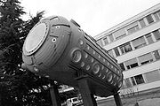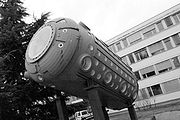
Gargamelle
Encyclopedia

Bubble chamber
A bubble chamber is a vessel filled with a superheated transparent liquid used to detect electrically charged particles moving through it. It was invented in 1952 by Donald A. Glaser, for which he was awarded the 1960 Nobel Prize in Physics...
detector at CERN
CERN
The European Organization for Nuclear Research , known as CERN , is an international organization whose purpose is to operate the world's largest particle physics laboratory, which is situated in the northwest suburbs of Geneva on the Franco–Swiss border...
, designed mainly for the detection of neutrino
Neutrino
A neutrino is an electrically neutral, weakly interacting elementary subatomic particle with a half-integer spin, chirality and a disputed but small non-zero mass. It is able to pass through ordinary matter almost unaffected...
interactions. Built in France, with a diameter of nearly 2 meters and 4.8 meters in length, Gargamelle held nearly 12 cubic meters of freon (CF3Br
Bromotrifluoromethane
Bromotrifluoromethane is an organic halide with the chemical formula CBrF3. Alternative names are Halon 1301, R13B1, Halon 13B1 and BTM.- Table of physical properties :- Uses :...
). The usage of a heavy liquid, rather than the more typical liquid hydrogen
Liquid hydrogen
Liquid hydrogen is the liquid state of the element hydrogen. Hydrogen is found naturally in the molecular H2 form.To exist as a liquid, H2 must be pressurized above and cooled below hydrogen's Critical point. However, for hydrogen to be in a full liquid state without boiling off, it needs to be...
, meant higher neutrino interaction probability, as well as easier identification of muons versus pions.
Gargamelle operated from 1970 to 1978 with a muon neutrino beam produced by the CERN Proton Synchrotron
Proton Synchrotron
The Proton Synchrotron is the first major particle accelerator at CERN, built as a 28 GeV proton accelerator in the late 1950s and put into operation in 1959. It takes the protons from the Proton Synchrotron Booster at a kinetic energy of 1.4 GeV and lead ions from the Low Energy Ion Ring at 72...
. These experiments led to one of the most important discoveries ever made at CERN: the experimental observation of the weak neutral current
Neutral current
Weak neutral current interactions are one of the ways in which subatomic particles can interact by means of the weak force. These interactions are mediated by the boson...
s was announced in July 1973, shortly after their theoretical prediction.
For the experiment, approximately 83,000 neutrino events were analysed, and 102 neutral current events observed. The signature of a neutral current event was an isolated vertex from which only hadron
Hadron
In particle physics, a hadron is a composite particle made of quarks held together by the strong force...
s were produced.
The name of the chamber derives from the giantess Gargamelle in the works of François Rabelais
François Rabelais
François Rabelais was a major French Renaissance writer, doctor, Renaissance humanist, monk and Greek scholar. He has historically been regarded as a writer of fantasy, satire, the grotesque, bawdy jokes and songs...
; she was Gargantua
Gargantua and Pantagruel
The Life of Gargantua and of Pantagruel is a connected series of five novels written in the 16th century by François Rabelais. It is the story of two giants, a father and his son and their adventures, written in an amusing, extravagant, satirical vein...
's mother.

